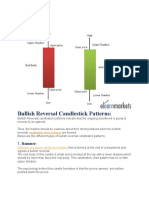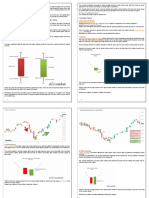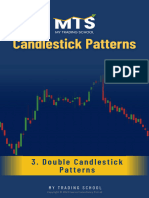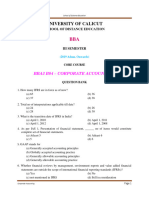Patterns
Bullish Candlestick Patterns:
1. Bullish Engulfing Pattern: This pattern occurs when a small bearish candle is followed by a
larger bullish candle that completely engulfs the previous candle. It suggests a reversal of
the downtrend and indicates potential buying opportunities.
2. Hammer: A hammer candlestick has a small body and a long lower shadow, resembling a
hammer. It signifies that buyers were able to push the price higher after a period of selling
pressure, indicating a potential trend reversal.
3. Piercing Pattern: This pattern consists of two candles, where the first is a bearish candle
and the second is a bullish candle that closes above the midpoint of the first candle. It
suggests a possible end to the selling pressure and a bullish reversal.
4. Morning Star: A morning star pattern forms with three candles. The first is a bearish candle,
followed by a small-bodied candle (can be bullish or bearish) which indicates indecision,
and finally a bullish candle that closes above the midpoint of the first candle. It is a strong
signal for a bullish reversal.
5. Bullish Harami: This pattern occurs when a small bearish candle is followed by a larger
bullish candle that is entirely contained within the range of the previous candle. It suggests
a potential trend reversal and buying opportunity.
Bearish Candlestick Patterns:
1. Bearish Engulfing Pattern: This pattern is the opposite of the bullish engulfing pattern. It
occurs when a small bullish candle is followed by a larger bearish candle that engulfs the
previous candle entirely. It suggests a reversal of the uptrend and indicates potential selling
opportunities.
2. Shooting Star: A shooting star has a small body and a long upper shadow, resembling an
inverted hammer. It indicates that sellers were able to push the price lower after a period of
buying pressure, suggesting a potential trend reversal.
3. Dark Cloud Cover: This pattern consists of two candles, where the first is a bullish candle
and the second is a bearish candle that closes below the midpoint of the first candle. It
suggests a possible end to the buying pressure and a bearish reversal.
4. Evening Star: Similar to the morning star, an evening star pattern forms with three candles.
The first is a bullish candle, followed by a small-bodied candle indicating indecision, and
finally a bearish candle that closes below the midpoint of the first candle. It is a strong
signal for a bearish reversal.
1
�5. Bearish Harami: This pattern occurs when a small bullish candle is followed by a larger
bearish candle that is entirely contained within the range of the previous candle. It suggests
a potential trend reversal and selling opportunity. The bearish harami indicates that buyers
initially attempted to push the price higher, but sellers regained control and pushed the
price lower, leading to a potential shift in market sentiment. Traders may interpret the
bearish harami as a signal to sell or take a bearish position in anticipation of a downtrend. It
is important to consider other technical indicators and market conditions to confirm the
potential reversal before making trading decisions based solely on the bearish harami
pattern.























































































